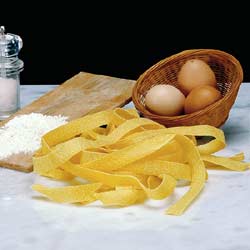| |
|
Alessi cuisine
|
|
| |
Walnuts-flavoured "lasagnole"
of Francesco Gaudenzio, cook and jesuit of the XVII century(Lasagnole al savor di noci di Francesco Gaudenzio,
cuoco e gesuita del XVII secolo)
|
- 400 grams of "lasagnole" (a type of pasta)
- 300 grams of minced veal
- a chopped mixture composed by:
1 white onion
2 carrots
1 garlic clove
1 rib of celery
some branches of parsley
a bunch of thyme
4-5 spoons of olive oil
the skin of a big lemon (but just the yellow part)
1 meat stock cube
200 grams of walnut's kernels
1/2 litre of skimmed milk
nutmeg
powder cinnamon
sugar
Parmesan cheese
white pepper
salt
|
 Take
a saucepan and put the bunch of thyme, oil and the chopped vegetables, let
them cook on a slow fire (without browning), very sweetly, turning and continuously
scraping the bottom of the pan, for 40 minutes or, alternatively, until
the chopped vegetables will not be too much cooked. Add the meat, turn and
mix, cook this meat on a slow fire together with the chopped vegetables
and the bunch of thyme, turn very carefully in order to avoid anything would
attach on the bottom of the pan or become coloured, and cook for, at least,
15 minutes. Take
a saucepan and put the bunch of thyme, oil and the chopped vegetables, let
them cook on a slow fire (without browning), very sweetly, turning and continuously
scraping the bottom of the pan, for 40 minutes or, alternatively, until
the chopped vegetables will not be too much cooked. Add the meat, turn and
mix, cook this meat on a slow fire together with the chopped vegetables
and the bunch of thyme, turn very carefully in order to avoid anything would
attach on the bottom of the pan or become coloured, and cook for, at least,
15 minutes.
Boil the milk and let it cool down; put it in the blender together with
the meat stock cube, the first 100 grs. of butter and the skin of lemon.
Mix these ingredients but without disintegrating them, grate 1/4 of nutmeg,
add 1/2 tea spoon of cinnamon and one big spoon of sugar, mix a little bit
more, pour this mixture in the saucepan, which is boiling very slowly.
Increase the heat a little bit and then, turning and carefully mixing, adjust
the heat in order to have a sweet boiling; let this stuff cook for at least
30 minutes, covering the pan with a lid and taking care anything would attach
on the bottom of the pan.
Then add this mixture and, if necessary, add some more salt and sugar in
order to have a very light bitter sweet flavour, after having turned the
mixture, switch off the heat.
Cook the pasta (it does not have to be too much "al dente"), drain
it (but not too much) and then drop it in a soup tureen and season it with
abundant "savor di noci", turn it very well diluting (if necessary)
with some more cooking water of the pasta, then cover with some more abundant
"savore" and uniformly spread the grated Parmisan cheese and the
remaining 100 grs of chopped walnuts.
Once the pasta is served in the dishes grind the white pepper over the "lasagnole"
with the aid of a pepper grinder, in order to enrich the flavours bouquet
and to brighten up the light bitter sweet flavour with a pungent note. |
|
|
|
|
| |
|
|
|
| |
|
|
|
|